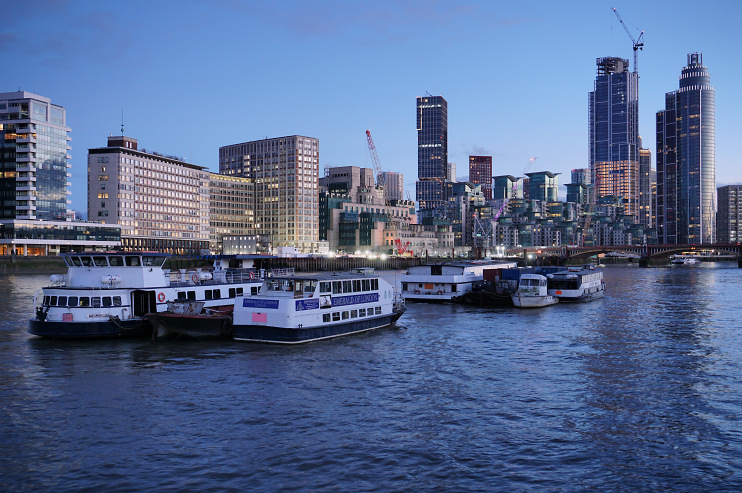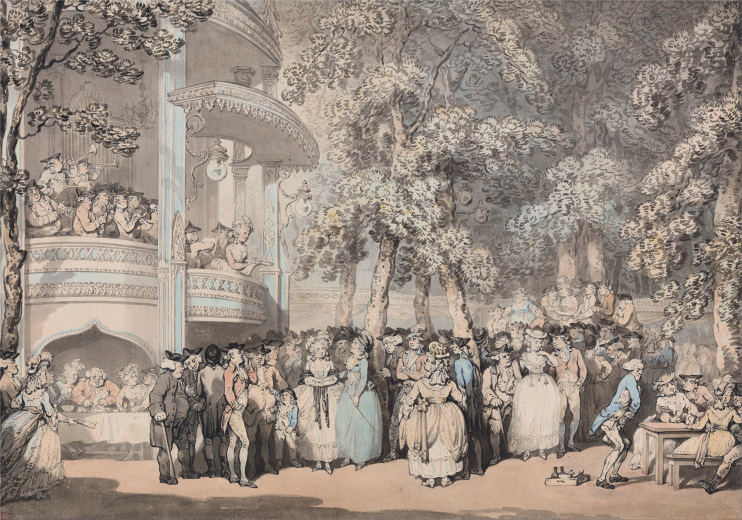Vauxhall
Vauxhall, Lambeth/Wandsworth
A recently transformed Thames-side locality and transport interchange in south-west Lambeth, formerly the site of London’s most fashionable pleasure gardens

The Gascon mercenary Falkes de Bréauté gained possession of the manor in 1233 through his marriage to wealthy widow Margaret de Redvers and built Falkes’ Hall, later called Fox Hall.
Jane Vaux, possibly a descendant of Falkes de Bréauté, owned a house here in 1615 with eleven acres of grounds called the Spring Gardens, which were opened as a pleasure park in 1660. Samuel Pepys recorded later in the decade that he went “by water to Fox-hall, and there walked in Spring Garden.”
The park reopened in 1732 with greatly enhanced attractions – and the construction of Westminster Bridge in 1750 improved its accessibility. The gardens provided refreshments, concerts, fireworks, displays of pictures and statuary and the like, and at night were lit by over 1,000 lamps. Thomas Rowlandson’s watercolour below (c.1784) shows a crowd of evening concertgoers, probably not long after the gardens reopened.
Such was the prestige of Vauxhall Gardens, as they were formally called from 1785, that similar parks were laid out in several cities, including the Tivoli Gardens in Copenhagen. In Russia, the grand station pavilion (where concerts were performed) at the Pavlovsk pleasure gardens was named Vokzal (Вокзал), because of Vauxhall’s synonymous association with musical entertainments. Pavlovsk was the destination of the first Russian railway line, which arrived there from St Petersburg in 1837, and the word vokzal came to mean ‘station’ in Russian and Russian-influenced languages such as Uzbek.
Vauxhall Gardens closed in 1859 after two decades of financial difficulties but a small remnant, Spring Gardens, survives opposite the northern end of South Lambeth Road. A little to the south, Vauxhall Park opened in 1890. Just across Tyers Street from Spring Gardens, Vauxhall City Farm has been “keeping the lamb in Lambeth” since 1976.
Industry and commerce flourished along Vauxhall’s riverside for more than three centuries, and until very recently continued to do so at Nine Elms.
The Vauxhall Ironworks Company built its first car in 1903, badged with Falkes de Bréauté’s heraldic griffin; a plaque at Sainsbury’s petrol station on Wandsworth Road marks the site of the factory. The company relocated to Luton in 1905 and became Vauxhall Motors two years later.
The present Vauxhall Bridge opened in May 1906, replacing the 19th-century Regent Bridge.
Much of Vauxhall was rebuilt with blocks of low-rise flats in the 1930s and parts had become very run-down by the early 1990s, since when the area has been transformed in a variety of ways. The Secret Intelligence Service (MI6) moved to a purpose-built headquarters at Vauxhall Cross in 1993 and other parts of the riverside have filled with luxury apartment blocks, notably at St George Wharf – visible just right of centre in the photo at the top, which was taken at the end of August 2021 – and more recently the Corniche, near the northern edge of the map below. Inland, surviving Georgian and Victorian terraced houses have been gentrified, while huge sums have been spent on the regeneration of council housing.
Vauxhall’s Lusophone community has opened cafés and restaurants, while a ‘village’ of gay bars and nightclubs has also evolved.
Transport for London completed London’s most distinctive bus station at Vauxhall Cross in 2004, with ‘ski-ramp’ solar panels that power most of the station’s lighting. Sadly, there has since been a proposal to knock it down and replace it with a smaller bus station and a pair of extremely tall towers with an 11-storey connecting podium, shown in the centre of the CGI below. Lambeth council’s planning committee approved the Vauxhall Cross Island scheme, by Zaha Hadid Architects, in December 2018. However, at the time of writing (February 2023) it’s still unclear what will eventually appear at this site.

Developers of new projects in south Vauxhall, such as the recently completed DAMAC Tower, nowadays usually claim they’re in Nine Elms.
The pleasure gardens crop up frequently in English literature down the centuries – for example, in Vanbrugh’s play The Provok’d Wife (1697), Dickens’s Sketches by Boz (1836–7) and Thackeray’s Vanity Fair (1847–8), although that novel’s Captain Dobbin finds “the Vauxhall amusements not particularly lively.” Thomas Hood’s At Shining Vauxhall is one of several poems inspired by the gardens.
Singer/songwriter Morrissey lived in the area for a while and released the album Vauxhall and I in 1994.

